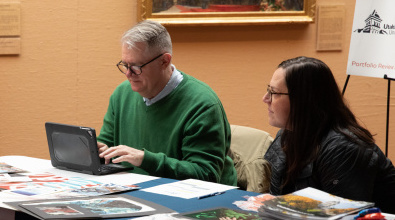| These are some of the schools that have participated in the past, the final list for this year will be updated before registration opens: Brigham Young University – Department of Art Brigham Young University – Department of Design Salt Lake Community College School of the Art Institute of Chicago Snow College Southern Utah University Southern Virginia University University of Utah USU Eastern - Price Campus Utah State University Utah Tech University (formerly Dixie State University) Utah Valley University Weber State University Westminster College Be Open-Minded This is only one step in the process of becoming a professional artist. You will get lots of feedback at this event; it is up to you to choose what advice you will follow and what advice you will disregard. Be aware that schools will not be offering on-the-spot scholarships to attendees. These interviews can help you, however, to connect with people who you might be working within college programs, and who may have an influential voice on scholarship decision committees down the road. Frequently Asked Questions What are they looking for in me as an artist? “Have an idea of where you want to go with your work.” -Morgan Nelson, Hein Academy of Art “Show us work that represents who you are as an artist, and not work that your teachers guided.” -Jessica Curran, Salt Lake Community College “The ability to self-edit and be critical of ones work. Being able to speak about the ideas behind the work are key. I don't want to hear 'My teacher assigned me to do this...' I want to hear why they were intrigued by the idea, and about what made it important to them." -Jeffrey Hanson, Southern Utah University What should I include in my portfolio? “Bring only your best and highest quality work. Only high quality reproductions if you do not bring originals.” -Adam Larsen, Snow College “Sketchbooks! Professors love to see the thinking process.” -Danielle Tolman, Snow College “Present more original work. References are okay, but only if I see a student activity seeking to study.” -Katie Liddiard, Center for Academic Study “Passion and determined effort.” -Ryan Brown, Center for Academic Study “I want to see more drawings from life and a personal area of focus.” -Peter Everett, Brigham Young University “Diverse in genres (i.e. not just portraits). Experimentation." -Amanda Beardsley, University of Utah "Examples of individual artistic style, vision, and concepts." -Justin Kunz, Brigham Young University "Life drawings, commercial art, photography, film/video animation." -Zac Elliott, Art Institute of Salt Lake City How much of my art should I bring? “I would encourage students to bring only their best work, not work from Jr. High. They should bring 10-15 of their best work not 30 of different quality.” -Trudy Richardson, Salt Lake Community College “More is not necessarily better.” -Rich Briggse, BYU- Idaho “We really only need to see a few pieces to see what a student ability is.” -David Belka, BYU- Idaho “Don’t bring everything. Only bring the best. That may be ten pieces for some students, while others may have about 15.” -Glen Blakley, Dixie State College “Quality is more important than quantity. I encourage students to edit their portfolios, realizing that they will be judged on their poorest work as well as their best." - Arlene Braithwaite, Southern Utah University How should I present my art? “A portable portfolio is easier to flip through.” -Scott Allred Snow College “I liked seeing the sketchbooks several students brought – nicely matted and well-presented portfolio pieces are a joy to review.” -Robert Barrett Brigham Young University “Presentation, I was very impressed with students that had matted and framed their work. It looks more professional and more put together.” -Nadia Morales Westminster College “Create a digital portfolio on a CD to leave with University Representatives.” -Noel Carmack USU Eastern Still have questions? Contact Chloe Hunter at 801-491-5707 or CHunter@springville.org |
